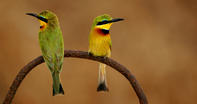
Name
Little Bee-eater (Merops pusillus)Appearance
This is the world’s smallest bee-eater at a length of 16 cm. The little bee-eater is bright green on top with orange or buff underparts, including the outer flight feathers. A black gorget (collar) separates the orange or buff breast from a yellow throat.The tail is orange or buff, with a green center. Like all bee-eaters, the little bee-eater has a black eye stripe, with turquoise spot above the eye.
Little Bee-eater Diet
The little bee-eater hunts flying insects, whilst in flight. Once they catch an insect, they will return to a perch, to kill the insect and remove its sting, by repeatedly hitting the insect against the branch. The little bee-eater prefers insects such as bees and wasps.Breeding
A tunnel is dug by both the male and female little bee-eater, normally in a vertical sandy bank or an aardvark hole. This tunnel can be as deep as 130 cm. They do not line the nest cavity and the 2 to 6 eggs are laid directly on the sand. The eggs are incubated by both sexes for around 20 days.This bee-eater is parasitized by the Greater Honeyguide (Indicator indicator).